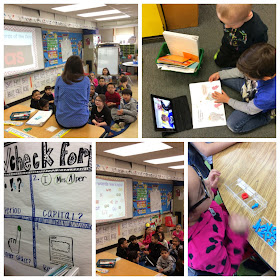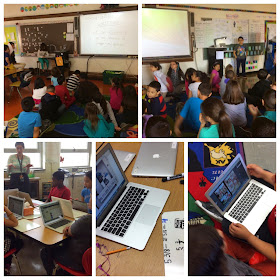A few months ago, I saw a video on the Teaching Channel (via Twitter, of course) that talked about Focused Walks in a high school. A team of teachers went into classrooms together and debriefed with each other. In D100, it reminded me of our old Internal Audit visits and our current Site Visit model for outside visitors. When I watched it, I was thinking more about the type of focus I could give when going with individual or small groups of teachers, either through the Mentor Program or as a coach. It wasn't until a few days later when +Lucy Carrera, our ESL teacher, sent me the same link and asked if we should do it with our staff. It was then that the idea of the Site Visit and the Mentor Program combined, and we decided to try and figure it out.
It took me almost 2 months to actually get a coverage schedule going, but we finally found a date where all our reading staff and ESL staff were available to cover classrooms teachers during their Encore Block. We had +Kristen Mcelheron, +Abby Cramton, and +Joana Martinez cover classes but still see their groups in the classrooms for the day. Our ESL teacher, Lucy, and our DRC, +Mary Fergus, covered a few classes and joined us on the walks. By covering classes, those teachers allowed for the whole grade level to get release time together to walk around the building for 30 minutes with me (the literacy coach). We walked for 20 minutes, and debriefed for 10 minutes.
With only 20 minutes of classroom visit time for each team, we decided to look at the grade below and above the team of teachers walking. When we went into those classrooms, we kept the 5 key shifts of Standards Based Learning/ Grading in mind as we observed. When we debriefed after, we kept the conversation around positive examples of those lenses.
Purpose for Learning/ Grading:
Do the students know the learning objectives? Are they clearly stated, verbally, on anchor charts, or dry erase boards?
Can the students tell us what they are doing, and why?
Specific Feedback:
Do we observe the teacher giving feedback, or the students giving feedback to each other?
Do we see evidence of feedback in place (students in different stages of learning, etc.)?
Do we see examples of written feedback?
Formative Assessment:
What activities are the students do, and what kind of formative assessment could they be?
What information could the teacher get from that assessment?
Student Self-Assessment:
Are the student evaluating their own learning?
CCSS Work/ Collaboration:
Do we see evidence of the standards in the classroom?
Do we see commonality of standards/ topics across the rooms?
**Commonality, not carbon copies. The CCSS determines what we teach, not how we teach it.
Here is a picture of our first team of teachers for the day.
8:50- 9:20 First grade visited K and 2 classrooms
9:30- 10:00 3rd grade visited 2nd and 4th grade classrooms
10:10- 10:40 5th grade visited 3rd and 4th grade classrooms
10:50- 11:20 2nd grade visited 1st and 3rd grade classrooms
1:10- 1:40 4th grade visited 5th grade classrooms, and one 3rd grade.
2:10- 2:40 Kindergarten visited 1st grade classrooms
 |
| 2nd grade writing from Focused Walk #1 |
 |
| Kindergarten learning from Focused Walk#1 |
 |
| 2nd and 4th Grade Learning from Focused Walk #2 |
 |
| 4th and 1st grade learning from Focused Walks #2 and #3 |
 |
| 1st grade learning from Focused Walk #3 |
 |
| 3rd and 5th grade learning from Focused Walk #4 |
 |
| 5th grade learning from Focused Walk #5 |
 |
| 1st grade math from Focused Walk #6 |
 |
| 1st grade math from Focused Walk #6 |
I debriefed with each team about the evidence of the 5 shifts that we saw in each grade level band. Some of the conversations that we had are below.
Purpose for Learning/ Grading:
For the most part, it seems that our students are able to tell us what they are working on. Some students could tell us why, or put it into the bigger picture. Many were able to tell us what their goal was for that lesson.
Specific Feedback:
We saw evidence of feedback in the grouping arrangements and the fact that students were in different stages of the writing process in the Writing Workshop lessons we observed. We did see feedback from teachers in Google Classroom, and in Showbie. There were a few classrooms that we caught students giving feedback to each other, too.
Formative Assessment:
5th grade was taking a math test, so that was a formal assessment. Other than that, there were no official assessments, but there was formative assessment everywhere. All the work the kids were doing could be used to check for their understanding before continuing to teach. Those teachers using Showbie and Google Classroom don't even have to physically collect anything to get the work, either. We didn't catch any exit slips on this walk, but those exist around the building too.
Student Self-Assessment:
There were a few cases of children assessing themselves, or using peer self-assessment. When students compared their learning to a class made rubric to see if they could move themselves along, or when they met with peers to explain their thinking, they were self-assessing. There were also students comparing their work to a rubric, and I think that we will continue to work on that type of assessment. For now, teacher feedback seems more effective for growth and movement compared to a rubric on their own.
CCSS Work/ Collaboration:
This was the best part of the walks, in my opinion. It is clear that our teachers all collaborate and plan lessons together. What was interesting to see was how each teacher on that team decided to teach it. In some grade levels, the exact same lesson was being taught, but using completely different instructional deliveries.
These Focused Walks exist for a few reasons, in my opinion.
1. They open the doors across the building for collaboration.
2. They allow us to see instructional design and decision making in action. We don't get to see that
when we meet without the kids.
3. They build Growth Mindset. There is something from every classroom that you can learn.
4. They increase our own self-reflection.
I think the biggest take away from this experience that I had was to use these lenses on our own classrooms. It is great to walk in and see the lessons that others do, but it shouldn't stop there. If we are always learning and growing, then when we come back from going in and out of classrooms, there is something that you can reflect on. Looking at those lenses, what do your students show others by their behaviors? What can you improve on? Or, what are you particularly good at? What can you share with others?
Thanks, Hiawatha staff, for going on this Focused Walk journey. I can't wait to plan our next one!



No comments:
Post a Comment